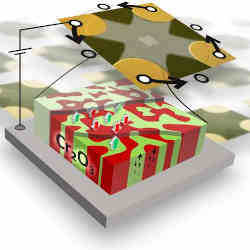
Antiferromagnentic materials (AFMs) are the elusive cousins of ferromagnetic materials (FMs). While the latter have been exploited by humans for millennia, the former were discovered in the 1930s.
The principle distinction between FMs and AFMs is the microscopic magnetic moments within FMs which comprise their magnetic domains, or regions of uniform magnetization, are aligned in parallel, while AFM domains form antiparallel orientations. Further, unlike FMs, AFMs have no external magnetism, rendering them magnetically invisibleand hard to detect or manipulate.
FMs such as nickel, cobalt, and certain compounds and alloys, are well-understood. Their domains are easy to manipulate with a magnetic field. Information can be read and written, and they are commonly found in hard disk drives and other data storage devices.
AFMs have intrinsic properties, such as resonances in the terahertz range, that make them desirable within computing. Yet for decades they have been a niche research topic because their material qualities make them extremely difficult to modify. Indeed, Louis Néel, the French physicist who first described them, declared AFMs to be "interesting but useless."
Recent discoveries have turned this notion on its head. Researchers have demonstrated new ways of manipulating AFMs. This raises tantalizing possibilities, from disruptive applications such as the replacement of silicon in future computers, to the invention of super-fast memory storage and new forms of artificial intelligence.
Are we there yet?
Peter Wadley, a physicist at the University of Nottingham in the U.K., was lead author of a 2016 paper that first demonstrated electrical switching in conducting AFMs, or the ability to modify them.
Building on predictions made at Prague's Institute of Physics and advances in spintronics, Wadley et al showed that alternating internal magnetic fields could be generated in AFMs by running an electrical current through them. The researchers were able to produce a prototype AFM memory device that they could pulse with a current and then read its state.
"AFMs typically have intrinsic dynamics 100 to 1,000 times faster than a similar FM. This means for a memory element — in the best-case scenario —you could manipulate it 1,000 times faster," says Wadley.
However, speed is not the only appeal of AFMs. As they do not generate a magnetic field (the reason they are hard to manipulate), they do not interact with neighboring magnetic fields and, in principle, have a higher packing density than FMs. "They are really robust to external fields, which your typical magnetic hard disk is not. You can usually put a magnet over the top of them without any fear of erasing data," says Wadley.
Wadley's discovery meant that certain AFMs, ranging from insulators through metals to superconductors, that were not previously considered functional could now be investigated.
However, Wadley stresses that there are many barriers to overcome before you could develop a hard disk from an AFM.
Their domain structures, for example, are not widely understood. This makes it difficult to tailor the correct energy barriers to preserve their magnetic state, he says.
The size of the readout signal is also a challenge. "On the one hand you need to make the writing efficient and stable, but on the other hand you need to be able to read it out easily." Typically in FMs, spin-valve structures are used to amplify the signal. However, due to material differences, this is not possible in AFMs.
Wadley's work helped to transform AFM research from a niche topic into a thriving field that is generating further discoveries. In a paper published in October 2019 in Physical Review Letters, Lorenzo Baldrati of Johannes Gutenberg-Universität Mainz, Germany, working with researchers from the U.K. and Japan, demonstrated the writing of information in the magnetic structure of insulating AFMs. Using electrical spin Hall magnetoresistance and direct imaging, the team showed that the magnetic domains can expand or shrink with the application of an electric current. This alters their structure, allowing reading and writing operations to be carried out.
Like Wadley, Baldrati believes many challenges remain, "We need to increase the magnitude of the reading and also demonstrate that this can be done fast enough." Further, everything needs to be scaled down before AFMs could be implemented in a device that could be competitive with silicon, for example. "We have demonstrated on the micron-scale in this first device; one needs nanometers," he says. "But at least we have the key operations of reading and writing."
AFMs are not only being investigated with a view to replicating current functionality in computing; researchers like Baldrati and Wadley are thinking about new applications. Wadley enthusiastically cites potential uses in spiking neural networks, a form of neuromorphic computing.
"The fact that AFMs are intrinsically multilevel [as opposed to binary] and decay is on timescale that we can control, means that you could think about putting together artificial brains and neural networks for processing," he says.
In the short term, Wadley expects AFMs to complement existing technology, then perhaps replace parts of it, even though they hold the potential to replace all of it.
Karen Emslie is a location-independent freelance journalist and essayist.



Join the Discussion (0)
Become a Member or Sign In to Post a Comment